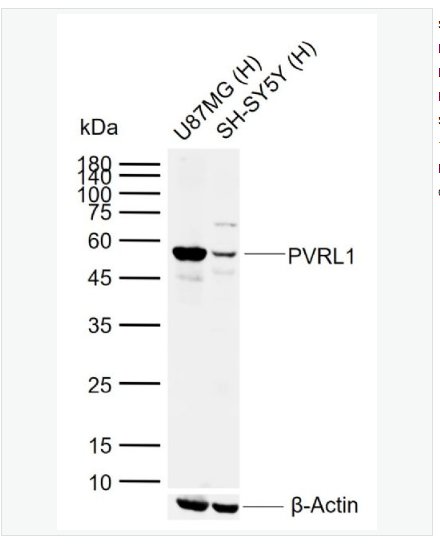Host:Rabbit
Target Protein:PVRL1
IR:Immunogen Range:31-130/517
Clonality:Polyclonal
Isotype:IgG
Entrez Gene:5818
Swiss Prot:Q15223
Source:KLH conjugated synthetic peptide derived from human PVRL1/CD111/Nectin1:31-130/517
Purification:affinity purified by Protein A
Storage:0.01M TBS(pH7.4) with 1% BSA, 0.03% Proclin300 and 50% Glycerol. Shipped at 4℃. Store at -20 °C for one year. Avoid repeated freeze/thaw cycles.
Background:Nectin is a Ca2+-independent homophilic cell adhesion molecule that belongs to the immunoglobulin superfamily. Human Nectin is identical to the poliovirus receptor-related protein (PRR) and is identified to be the alphaherpesvirus entry mediator. Nectin constitutes a family consisting of at least nectin 1, 2 and 3. Nectin 2 and 3 are ubiquitously expressed, whereas nectin 1 is abundantly expressed in the brain. Nectin 1 exists as nectin 1? and 1∫/HIgR, produced by alternative splicing. The cytoplasmic regions of Nectin 1?, but not Nectin 1∫/HIgR, have a C-terminal conserved motif (E/A-X-Y-V). This motif interacts with the PDZ domain of the F-Actin-binding protein, afadin, through which it is linked to the Actin cytoskeleton. Nectin 1, also designated HveC/ PRR1, allows the entry of herpes simplex virus type 1 (HSV-1) and HSV-2 into mammalian cells. The interaction of virus envelope glycoprotein D (gD) with nectin 1 is an essential step in the process leading to membrane fusion; the gD binding site is located at the first Ig-like domain of Nectin 1. Both the transinteraction of nectin and the interaction of nectin with afadin are necessary for their co-localization with E-cadherin and catenins at adherens junctions.
Size:50ul
Concentration:1mg/ml
Applications:WB(1:500-2000)
ELISA(1:5000-10000)
IHC-P(1:100-500)
IHC-F(1:100-500)
ICC(1:100-500)
IF(1:100-500)
Cross Reactive Species:Human
Mouse
Rat
Dog
Cow
Rabbit
